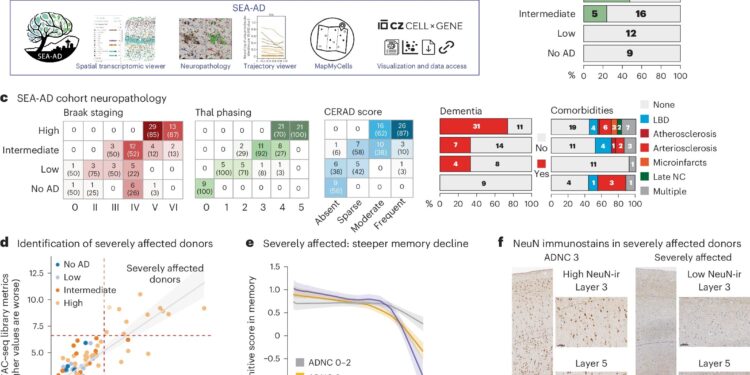SEA-AD study of MTG and description of the cohort. Credit: Natural neuroscience (2024). DOI: 10.1038/s41593-024-01774-5
Alzheimer’s disease may damage the brain in two distinct phases, according to new research using sophisticated brain mapping tools. According to the researchers who discovered this new insight, the first, early phase occurs slowly and silently, before people experience memory problems, damaging only a few vulnerable cell types. In contrast, the second, late phase causes more destructive damage and coincides with the onset of symptoms and the rapid accumulation of plaques, tangles and other hallmarks of Alzheimer’s disease.
“One of the challenges of diagnosing and treating Alzheimer’s disease is that much of the damage to the brain occurs well before symptoms appear. The ability to detect these early changes means that, for “For the first time, we can see what happens to a person’s brain during early periods of the disease,” said Richard J. Hodes, MD, director of the NIH National Institute on Aging. “The findings fundamentally change scientists’ understanding of how Alzheimer’s disease damages the brain and will guide the development of new treatments for this devastating disease.”
Scientists analyzed the brains of 84 people and the results, published in Natural neurosciencesuggest that damage to a type of cell, called an inhibitory neuron, during the early phase can trigger the problems in the neuronal circuitry that cause the disease. Additionally, the study confirmed previous findings about how Alzheimer’s disease damages the brain and identified many new changes that can occur during the disease.
Specifically, scientists used advanced genetic analysis tools to study cells in the middle temporal gyrus, a part of the brain that controls language, memory and vision. The gyrus has been shown to be vulnerable to many of the changes traditionally seen in Alzheimer’s disease. It’s also a part of the brain that researchers have carefully mapped for control donors. By comparing data from control donors with that of people with Alzheimer’s disease, scientists created a genetic and cellular timeline of what happens throughout the disease.
Traditionally, studies suggest that the damage caused by Alzheimer’s disease occurs in several stages characterized by increasing levels of cell death, inflammation, and protein accumulation in the form of plaques and tangles. In contrast, this study suggests that the disease changes the brain in two “epochs” – or phases – with many of the changes traditionally studied occurring rapidly during the second phase. This coincides with the appearance of memory problems and other symptoms.
The results also suggest that the first changes occur gradually and “discreetly” during the first phase, before symptoms appear. These changes include a slow buildup of plaques, activation of the brain’s immune system, damage to the cellular insulation that helps neurons send signals, and the death of cells called somatostatin inhibitory (SST) neurons.
This latest discovery surprised the researchers. Traditionally, scientists thought that Alzheimer’s disease primarily damaged excitatory neurons, which send activating neuronal signals to other cells. Inhibitory neurons send calming signals to other cells. The paper’s authors hypothesized that the loss of SST inhibitory neurons could trigger the changes in the brain’s neural circuits that cause the disease.
Recently, a separate brain-mapping study by MIT researchers found that a gene called REELIN may be associated with the vulnerability of certain neurons to Alzheimer’s disease. It also showed that star-shaped brain cells, called astrocytes, can provide resilience or resist damage caused by disease.
Researchers analyzed brains that were part of the Seattle Alzheimer’s Disease Brain Cell Atlas (SEA-AD), designed to create a highly detailed map of brain damage that occurs during the disease.
The project was led by Mariano I. Gabitto, Ph.D., and Kyle J. Travaglini, Ph.D., of the Allen Institute in Seattle. Scientists used tools developed as part of the NIH’s Brain Research Through Advancing Innovative Neurotechnologies (BRAIN) initiative – Cell Census Network (BICCN) – to study more than 3.4 million brain cells from deceased donors at different stages of Alzheimer’s disease. Tissue samples were obtained from the Adult Changes in Thought Study and the University of Washington Alzheimer’s Disease Research Center.
“This research demonstrates how the powerful new technologies provided by the NIH BRAIN initiative are changing the way we understand diseases like Alzheimer’s. Using these tools, scientists were able to detect early cellular changes in the brain to create a more complete picture of what is happening over the course of the disease,” said John Ngai, Ph.D., director of The BRAIN Initiative.
“The new knowledge provided by this study could help scientists and drug developers around the world develop targeted diagnostics and treatments for specific stages of Alzheimer’s disease and other dementias.”
More information:
Mariano I. Gabitto et al, Integrated multimodal cellular atlas of Alzheimer’s disease, Natural neuroscience (2024). DOI: 10.1038/s41593-024-01774-5
Provided by the National Institutes of Health
Quote: Alzheimer’s disease can damage the brain in two phases (October 20, 2024) retrieved October 20, 2024 from
This document is subject to copyright. Except for fair use for private study or research purposes, no part may be reproduced without written permission. The content is provided for informational purposes only.



